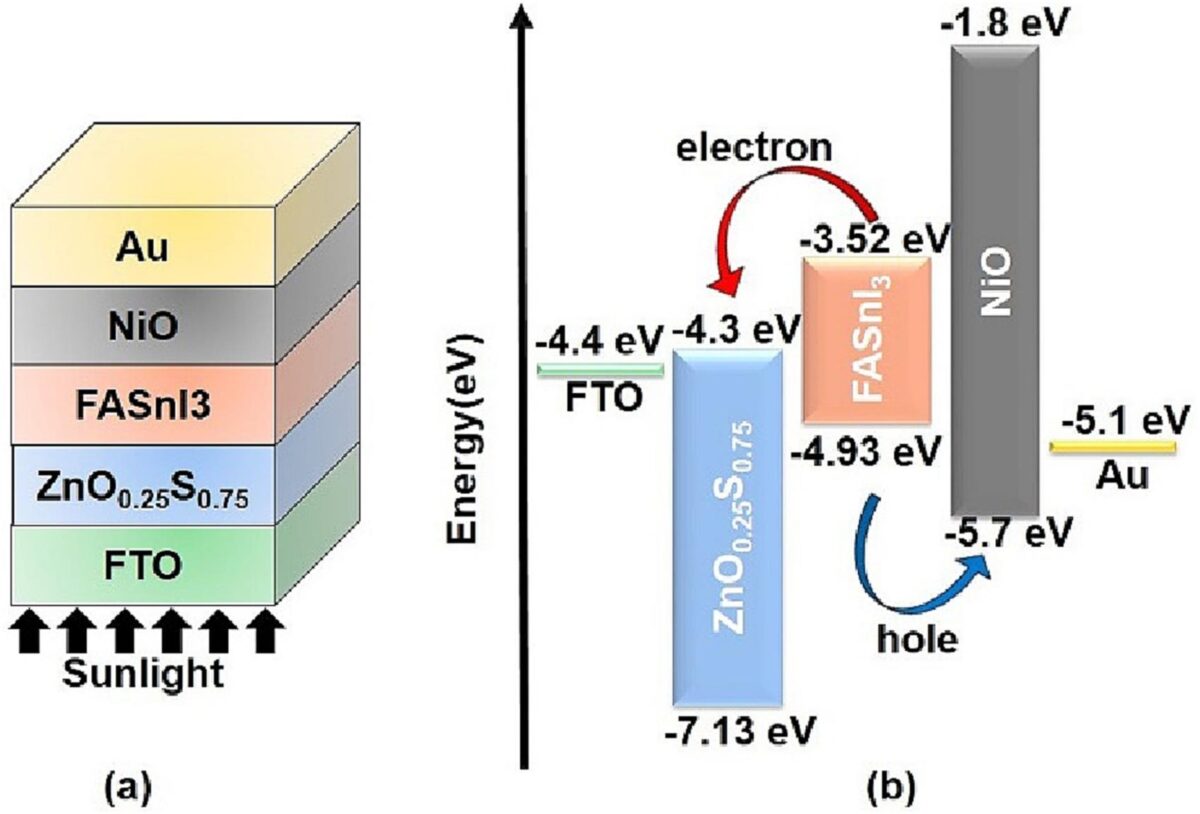Researchers at the National Institute of Technology (NIT), Silchar, Assam have designed a FASnI3 active layer-based perovskite solar cell device with an admirable 31.57% power conversion efficiency using nickel oxide (NiO) as the hole transport layer (HTL) and zinc oxy-sulphide (ZnO0.25S0.75) as the electron transport layer (ETL).
The proposed Au/NiO/FASnI3/ZnO0.25S0.75/FTO solar cell device structure revealed an exceptional open-circuit voltage (Voc) of 1.2419 V, short-circuit current density (Jsc) of 28.35 mA/cm2, Fill Factor (FF) of 89.64%, and power conversion efficiency of 31.57%, suitable for next-generation lead-free and eco-friendly solar cell device applications.
The researchers designed and investigated the Au/NiO/FASnI3/ZnO0.25S0.75/FTO device structure using SCAPS-1D solar cell capacitance simulator at AM 1.5G illumination, 1000 W/m2 incident power, and 300 K temperature
The performance parameters of the proposed solar cells device structure were investigated with variations in the active layer (FASnI3) thickness, defect density, and doping concentration; and variations of NiO HTL and ZnO0.25S0.75 ETL thickness, electron affinity, and doping concentration to obtain higher performance. Moreover, the influence of series and shunt resistance and temperature on the performance parameters of the proposed solar cell device structure was inspected.
“The FASnI3 parameter variations revealed that to attain high solar cell efficiency, optimal FASnI3 thickness, defect density, and doping concentration are desired, facilitated by the decent number of photons absorption and restricted non-radiative recombinations,” Robin Khosla, part of the research team and assistant professor at National Institute of Technology (NIT) Silchar, told pv magazine.
“Additionally, the thickness, electron affinity, and doping density variations of NiO HTL publicized that electron affinity-assisted trifling valence band offset and low series resistance of NiO promote good solar cell efficiency. Moreover, the ZnOS ETL scaled thickness, reasonable electron affinity, and moderate doping concentration showed superior device performance enabled by inconsequential conduction band offset and recombination current. A low series resistance, high shunt resistance, good thermal stability, and fewer interface defects marked excellent performance and reliability of the FASnI3 solar cell devices.”
The research findings are reported in Results in Optics. The research team included Robin Khosla, Srinivas Mattaparthi, Dipesh K. Sinha, and Aditya Bhura.
This article was modified on May 19, 2023 to include additional inputs from NIT Silchar.
This content is protected by copyright and may not be reused. If you want to cooperate with us and would like to reuse some of our content, please contact: editors@pv-magazine.com.









2 comments
By submitting this form you agree to pv magazine using your data for the purposes of publishing your comment.
Your personal data will only be disclosed or otherwise transmitted to third parties for the purposes of spam filtering or if this is necessary for technical maintenance of the website. Any other transfer to third parties will not take place unless this is justified on the basis of applicable data protection regulations or if pv magazine is legally obliged to do so.
You may revoke this consent at any time with effect for the future, in which case your personal data will be deleted immediately. Otherwise, your data will be deleted if pv magazine has processed your request or the purpose of data storage is fulfilled.
Further information on data privacy can be found in our Data Protection Policy.